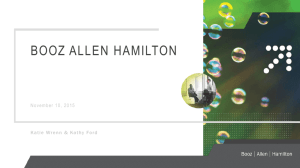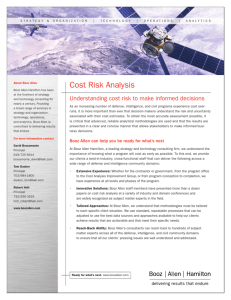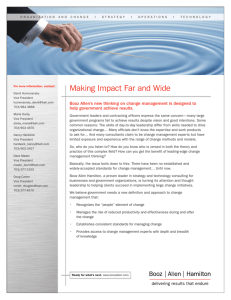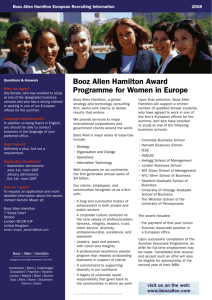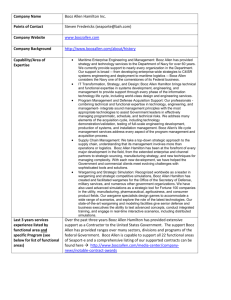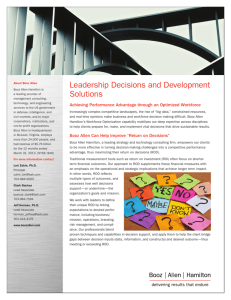Winning the Multi-Channel Challenge
advertisement
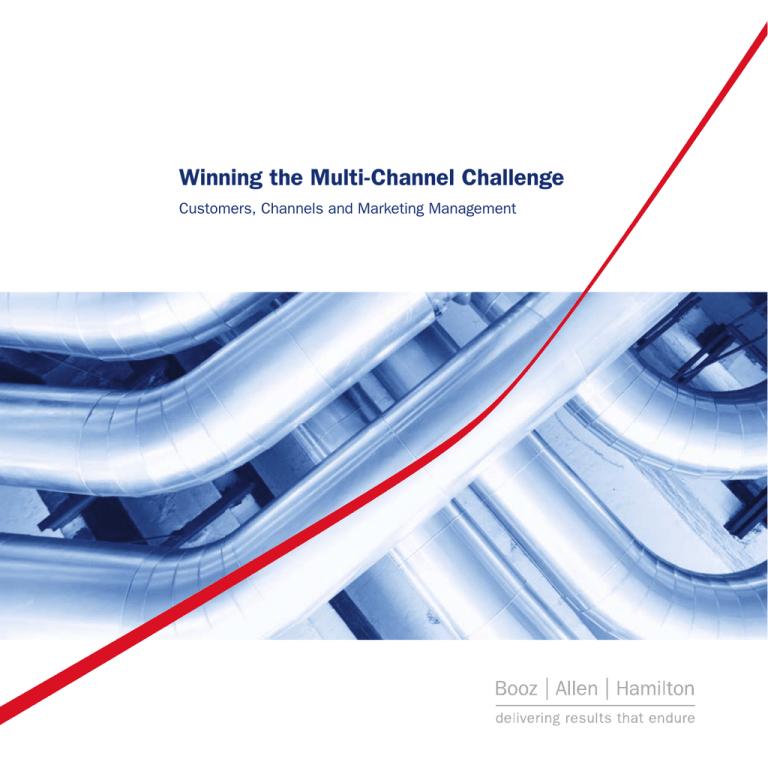
Winning the Multi-Channel Challenge Customers, Channels and Marketing Management It was clear that the arrival of the internet as the new medium for interaction with customers would disrupt multi-channel configurations. It was less clear what form this disruption would take, how long it would last or what new multi-channel configurations would emerge. As it turned out, the internet’s impact was less dramatic in the short-term than expected. In recent years, however, the pace of change has accelerated. In travel, for example, the organization of trips and booking behavior have changed dramatically since 2000 (see figure 1), and revenues generated online have been growing strongly (see figure 2). A recent Booz Allen Hamilton survey covering five industries in seven European countries showed that adaptation is, however, still far from complete in most industries, and in some industries, still in its infancy. I The study showed that up to 40% Figure 1: Organization of Vacation Trips (in %) of customers are not being served effectively, because companies cannot 46% target specific customer needs with their existing channel set-ups. This 35% 34% +31% 29% suggests a substantial portion of –15% marketing and sales budgets is being 9% wasted. 4% Component-Based Travel Individually Organized The usual adaptation pattern has been the extension of mail order processes 2000 +125% Pre-Packaged Tours 2004 Source: German Tourism Analysis 2005, B.A.T. Freizeit-Forschungsinstitut GmbH to the internet initially, followed by the establishment of e-commerce as a separately managed, independent channel, followed by movement towards truly integrated multi-channel management. Figure 2: Tourism: Online Turnover in Europe (in Bn. EUR) 23.0 Although this third stage is still far from 20.1 complete, enough trials and errors 17.0 have been made to reach provisional 12.7 conclusions about how the process of reconfiguring the customer interac- 8.4 tion channels, including the internet, 4.8 call centers, direct mail, retail stores, wholesale and partners, is best managed, and what industry-specific factors need to be taken into account. 2.5 0.8 1999 2000 2001 2002 2003 2004 2005 2006 Source: Car. H. Marcussen, Centre for Regional and Tourism Research Bornholm (CRT) 3I Multi-Channel Success Factors Our analysis shows that three basic principles are common to all successful multi-channel management practices across industries: 1. Align channels to customer segments Starting with a precise customer segmentation (“micro segmentation”), sales and service preferences (price, convenience, etc.) are established ”In igen tell tc m er usto segm tio en t a for each segment, and channel set-up is adapted to reflect them. 2. Intertwine products and channels Offering “bundles” comprising varying blends of product, channel, brand and service attributes, are assembled, the channel’s role in the sales process (e. g. is it just for distribution or does it play a more dynamic role?) These success factors are more easily is determined and specific bundles are assigned to specific customer described than realized, however. The segments. whole organization must contribute to achieving them. The overall challenge 3. Use IT to drive efficiency can be seen as a pyramid of challeng- A set of IT front-ends are customized for each segment, but a cross-channel es, from aligning channel strategy with customer view is maintained with a unified back-end spanning all chan- company strategy, down to embedding nels. This allows segments and bundles to be mixed and matched so that the channel strategy and its associat- even small segments can be addressed efficiently. ed propositions in the basic processes of the organization. I4 n and ase the average turnover by two to three percent“ proach can incre p a c fi i c a spe Gregor Harter, Booz Allen Ha milton Strategic Multi-Channel Management The channels a company uses to interact with its customers, and how it uses them, affect revenues, revenue growth and costs; help determine agility and efficiency; and contribute significantly to the company’s reputation in its marketplace. Channel configuration gives shape to a company, determines its sensitivity to its changing environment and characterizes the ways in which it engages with its customers. In short, multi-channel management is of vital strategic importance. That is why successful companies analyze multi-channel developments very carefully, and see them as key considerations in the strategy formulation process (see figure 3). Corporate strategy, defined as the way to reach the firm’s long-term goals, direction and business model, is the foundation of channel configuration. Analysis of the multi-channel status quo and the trends in the industry is an integral part of the analysis and synthesis phases of the strategy formulation process. 5I Figure 3: Strategic Multi-Channel Framework Company Strategy Channel Strategy & Propositions Commercial Capabilities Technical Capabilities Organization & Processes I6 Channel Strategy Channel Set-Up Once the overall strategy has been agreed, a ‘channel Agreement on a channel strategy will bear new questions. strategy’ and channel propositions can be derived from it. Should the channels be operated in-house, or through an Put simply, a channel strategy emerges from the answers independent subsidiary? If product and service supplied to three questions: Which customers should we target? by other companies (perhaps in other industries) are to be What products do they want? What channels are best bundled, how will decisions be made? How are investment suited for which products and which customers? and operating costs to be distributed among participating companies? Who owns the customer data and should their use be restricted? Figure 4: Overview of Channel Usage Sales Channels Usage 100% 100% 75% 75% 50% 50% 25% 25% 1) 1) Industry Automotive Travel Call Center Insurance Banking Internet Captive Shops Service Channels Usage Telco Third-Party (Retailer) Shops 2) 3) Automotive Travel Industry Insurance Banking Telco Source: Booz Allen Analysis 1) Very low sales amounts for new vehicles; however increasing internet-use for search and configuration 2) Mainly for younger vehicles 3) Mainly for older vehicles 7I Necessary Capabilities Active multi-channel management, which successfully balances the twin needs for efficiency and effectiveness, requires well defined commercial and technical capabilities. Commercial Capabilities There are two key requirements for successful multi-channel management: an intimate knowledge of the customer and the ability to use that knowledge to adapt different channels to the particular needs of different customers and segments (see figure 5). Customer needs must be served seamlessly across all channels. All current and recent customer transactions have to be accessible to all channels and customer value need to be known in all channels. This is a major challenge for companies, because the components of channel landscapes will often have evolved independently. Many companies still manage their webbased channels separately from conventional channels in so-called “eCommerce departments”. Companies must also be able to differentiate the attributes of the offering (products, services, prices and content) for the different channels, because channels vary in their effectiveness and efficiency. Figure 6 shows the efficiency and effectiveness of different sales and distribution channels in the travel industry. The ideal sales channel has high throughput at the lowest distribution cost per unit. Some low cost carriers already book 60% of their revenues directly online. But the optimal channel mix will vary from industry to industry, company to company, and customer segment to customer segment. To “manage” channels and actively encourage customers to switch to their most effective and efficient channel requires full transparency of each channel’s performance. I8 Figure 5: Current Channel Usage and Future Trend – Banking Example Channel Usage1) Trend Usage Behavior 70-75% Telephone/ Service Center 5-7% OnlineDistribution 20-25% ➔ ➔ Branch/ Personal Contact ■ ■ ■ ■ Mobile Banking 3-5% ➔ ➔ ■ ■ ■ ■ ■ ■ About 80% of customers prefer branch offices and personally delivered investment advice and information But customers are generally dissatisfied with the quality of advisory services The telephone is the normal channel for urgent transactions, e.g. loss of credit card 53% of customers dislike automated telephone services Online users are ”early adopters“ (younger, higher income); 10% do almost all their banking online Online banking for information and easy transactions (transactions 50%, change of address 14%) Increasing e-mail usage due to secure e-mails Supplementary channel Personal advisory services outside working hours Several banks have set up their own mobile sales forces to support their branch offices 1) Customers may have mentioned more than one channel Source: Forrester Research, Handelsblatt, Booz Allen Analysis Figure 6: Channel Differentiation – Travel Industry Example Increase of Throughput? Low Throughput, Low Cost High Throughput, Low Cost Ideal State Direct High Efficiency Cancel Provisions OLTAs 1) 3rd Party Shops Low Destination Agencies Low Throughput, High Cost Call Centers Low Cost Reduction? Own Shops High High Throughput, High Cost Effectiveness 1) Online Travel Agencies 9I Armed with the necessary management information a channel independent service-oriented and scalable transac- ‘steering logic’ and business-driven configuration abilities tion layer that enables the functional integration of different can be developed, to enable the differentiation of service front-end and back-end systems. In addition to its integra- offerings and to drive channel conversion. tion capability the middleware-layer must support channel management and buffering/caching mechanisms to ensure Technical Capabilities overall system performance given the poor look-to-book A multi-channel capable IT architecture is essential if efficient ratios of web-based business. A full set of front-end tech- offerings are to be delivered to customers across all chan- nologies must be supported to serve legacy sales channels nels. A basic multi-channel architecture comprising a front- and web-based platforms. The front-end should support end, a middle layer and a back-end is shown in figure 7. open industry standards (XML, web-services, etc.), and be The engine-room of a multi-channel IT architecture is a flexibly re-configurable, based on user-serviceable Figure 7: Channel Architecture – Banking Example Frontends Internet Call Center Self Service Devices Comprehensive MiddleLayer Internal Backends External Systems I 10 Branch Service Center Product Range Channel-Independent Transaction Layer Transactions Customer Booking e.g. Loan, Credit/Debit Cards, Insurances, Home Loan Banks Securities Processing parameters. The back-end must connect, not only to proach with processes that integrate all available chan- internal legacy systems, but also increasingly to external nels. For example, generated leads must be subsequently systems to access 3rd party services, such as external pursued by the most appropriate channel, irrespective of bed-inventories in the travel industry. where they have originated (mail, website, call center, etc.). Because companies seldom own all the channels they Organization and Processes serve this usually involves processes that cross corporate The integrated, multi-channel philosophy must permeate boundaries. For example, a car manufacturer’s own chan- the organization and its sales processes, to keep pace with nels (website, call center) should be closely linked to those the constantly evolving environment. The whole organization of the dealers who actually sell its vehicles, because every must be intimate with each channel and each customer lead generated must be steered to a dealer for proper fol- segment, while maintaining a coherent cross-channel ap- low-up (e.g. arranging a test drive). Figure 8: Cross Organizational Channel Links Example: Linking Pins between Sales/ Marketing Channels – Car Maker Organizational Links: n Automated Central Sales n Regular Sales & MarketingCoordination Plans Comprehensive Sales & Marketing Standards n n n Regular Communication Sales Force as Linking Pin Common Procedures Dealer/ Retailer Integrated Processes Web Call Center Direct Mail Retail Store End Customer 11 I Cross-Industry Lessons and Partnerships The study found a number of examples where industries could learn from each other’s experience. Elements of leading multi-channel capabilities have not fully penetrated all industries equally. While banks for example sell a great deal of product on the net, they do not yet offer detailed product configuration options. They are advised to analyze how successful automotive players use the internet to inform their customers about options and features. Although car manufacturers sell very few new cars online they offer great options and product /car configuration flexibility via the internet to address the increasing number of customers who start a transaction there before entering a retail show room. Travel companies can learn from the telecommunication industry’s sophisticated approach to customer micro segmentation (e.g. Heya, a Polish mobile brand specifically targeted towards young people), and the clarity of its channel differentiation, but telecommunication companies can learn from the travel sector’s use of bespoke processes for premium customers (e.g. HonCircle from Lufthansa). In most industries the number of customers who can be addressed through the standard channel offering is declining. Our study suggests that a fast and cost efficient way to develop the multi-channel offering further is through partnerships. Cross-industry partnerships in particular offer possibilities to extend the channel offering without encountering competition. I 12 Tchibo, a former German coffee brand and now one of the country’s largest retailers, shares its sales structures, from retail outlets to internet portals and call centers, with various partners, to sell telco services, loans and travel. Its partners, such as the Royal Bank of Scotland, benefit from much reduced market entry barriers, while Tchibo earns commissions on such sales and achieves a more stable customer base. Other examples of such successful channel sharing include Lufthansa Miles & More, Douglas in cooperation with German savings bank outlets, and the use of Tesco’s retail outlets to sell banking products and pharmaceuticals. I Conclusion Customer segmentation within a multi-channel strategy is a vital first step towards improving the way customers are addressed. The ultimate goal is to offer bundles of product, channel, brand and service carefully tailored for specific segments and effectively supported by IT. “Booz Allen Hamilton, a global strategy and technology consulting firm, works with clients to deliver results that endure.” I Booz Allen Hamilton has been at the forefront of manage- In 2005 and in 2006, Fortune magazine named Booz Allen mentt consulting for businesses and governments for more one of “The 100 Best Companies to Work For,” and for than 90 years. Integrating the full range of consulting the past seven years, Working Motherr has ranked the firm capabilities, Booz Allen is the one firm that helps clients among its “100 Best Companies for Working Mothers.” solve their toughest problems, working by their side to help them achieve their missions. Booz Allen is committed to To learn more about the firm, visit the Booz Allen Web site delivering results that endure. at www.boozallen.com. To learn more about the best ideas in business, visit www.strategy-business.com, the Web site With 18,000 employees on six continents, the firm generates for strategy + business, a quarterly journal sponsored by annual sales that exceed $3.7 billion. Booz Allen has been Booz Allen. recognized as a consultant and an employer of choice. Customers, Channels and Marketing Management — Key Contacts Europe Johannes Bussmann Lenbachplatz 3 80333 Munich Germany +49-89-54525-0 bussmann_johannes@bah.com www.boozallen.de United States Evan Hirsh Key Tower, Suite 5300 127 Public Square Cleveland OH 44114 +1-216-696-1900 hirsh_evan@bah.com www.boozallen.com Gregor Harter Lenbachplatz 3 80333 Munich Germany +49-89-54525-0 harter_gregor@bah.com www.boozallen.de Latin America Ivan de Souza Avenida Nacoes Unidas, 12.901 Torre Norte 18o e 19o andares Sao Paulo SP 04578 - 000 Brazil +55-11-5501-6200 de_souza_ivan@bah.com www.boozallen.com Asia Pacific Vanessa Wallace Level 7 7 Macquarie Place Sydney NSW 2000 Australia +61-2-9321-1900 wallace_vanessa@bah.com www.boozallen.com.au Contributing Team Olaf Acker Jörg Böckmann Holger Brohm Joachim Deinlein Volkmar Koch 15 I Multi-Channel Service Offering Booz Allen Hamilton as a Competent Partner Industry Expertise ■ Deep industry know-how via industry-specific teams ■ Leading know-how in industry related channel strategies ■ International benchmarks across industries CRM Expertise ■ Comprehensive experience in CRM related topics esp. Sales, Marketing, Pricing and CRM applications ■ Development of concepts for channel acquisitions, channel marketing, field sales and POS performance ■ Design of partnering strategies Multi-Channel Team ■ Dedicated cross-industry/ cross-functional expert team ■ International experience ■ Broad engagement experience ■ Variety of studies and surveys ■ Proven methodologies and tools ■ Knowledge Online Functional Expertise ■ Strategy development and implementation ■ Process efficiency improvement and organizational design ■ Measurement & reward system design, channel metrics and controlling ■ IT team with broad CRM and channel know-how (industry-specific)
